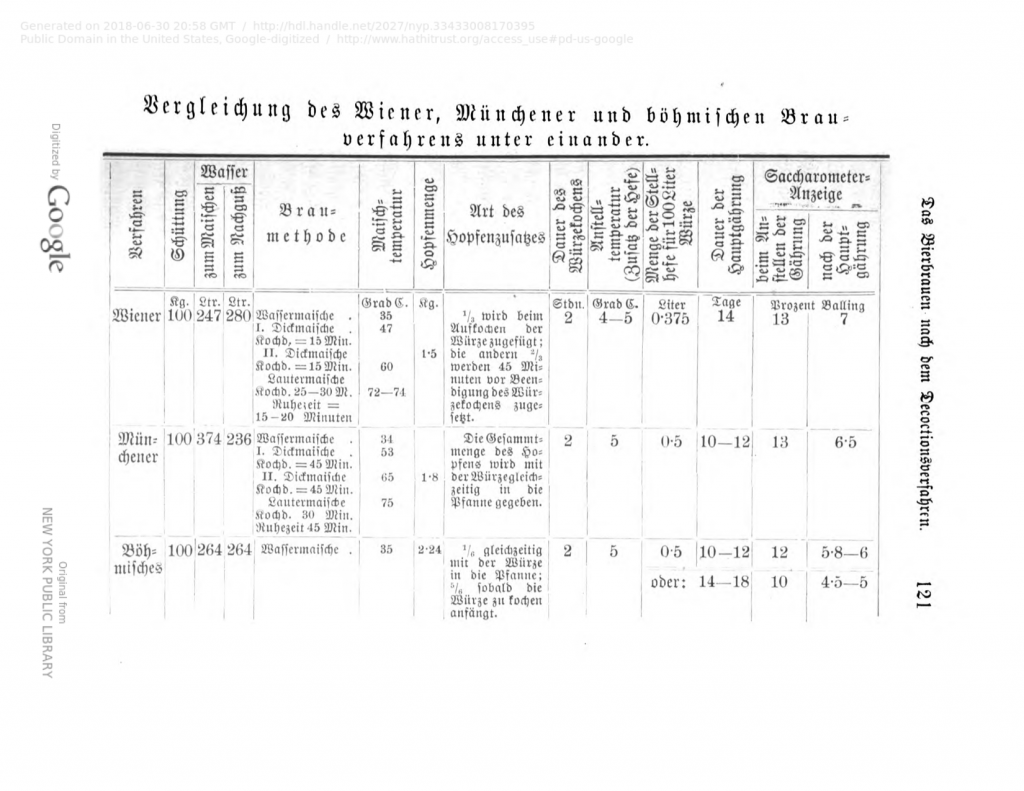In several previous postings, I wrote about various details in my effort to reconstruct historic Vienna lager as it was brewed in the 19th century by Viennese breweries, in particular Anton Dreher’s Kleinschwechater Brauerei, and exported all over Europe.
In a posting about a month ago, I discerned various mashing methods as they were described in the 1887 book “Die Dampf-Brauerei. Eine Darstellung des gesammten Brauwesens nach dem neuesten Stande des Gewerbes” by Franz Cassian. Despite all the interesting information that I was able to get out of that book, I missed one particular table much earlier in the book that shows a brief but informative overview over how Munich lager, Vienna lager, and Bohemian lager are brewed.
(click on the image to expand)
While much of this information was already known to me, there are a few more interestings bits and pieces in there: it lists a hopping rate of 1.5 kg per 100 kg of malt (which, after some calculation, should be roughly equivalent to between 3.45 g/L and 3.75 g/L). We get a hop boil time (2 hours), and a more detailed hopping schedule: 1/3 of the hops are added to the first runnings (so-called first wort hopping), while the remaining hops are added 45 minutes before the end of the boil. Unfortunately, the same book describes this just a few pages afterwards in words, and there it says that 2/3 of the hops are added 45 minutes after the beginning of the boil. At a 2 hours boil, that would be 75 minutes before the end of the boil. Personally, I find the latter a bit more convincing.
It also lists 13° as the OG of Vienna lager. Both the OG and the hopping rate corroborate previous findings from other pieces of literature. While not exactly new information, it adds much more confidence to this information.
All in all, we’ve now got the following information about historic Vienna lager:
- Original gravity: about 13 °P
- ABV: about 4.6%
- Final gravity: about 4 °P
- Hopping rate: 3.3 to 3.6 g/L
- Boil time 2 hours, with hop schedule as described above
- Hop variety: Saaz
- Base malt: Vienna malt
- Mashing schedule: triple decoction (more details here)
This information is pretty complete, and in fact quite detailed. The only things I would say are not 100% clear are the exact specs of historic Vienna malt such as colour, modification and barley variety (which means we need to trust commercially available modern Vienna malt), and the brewing water that was used. To give you a hint about what the ground water in Schwechat is like, you can find current water analysis data online. This is of course not a guarantee that the water profile is authentic. The water may have changed through 150 years of modern farming, and the brewery could have treated the local water, which would change everything. In any case, the important point about the water is that Viennese water is not necessarily right, as Schwechat’s water source is separate from Vienna’s, and Vienna’s water sources have changed in the last 150 years.
Nevertheless, quite a lot of information about Vienna lager has now been confirmed through historic sources, some of them even through multiple sources, which gives me greater confidence than ever before that Vienna lager brewed based on the specs above is as close to the historic original as possible.


Which beer is that exactly? It looks like Vienna Lager. Though, of course, they also brewed Märzen and Export strength versions.
That table looks very much like one in Wahl & Henius. It’s probably where they nicked it from.
They’re not particularly specific which exact beer it is. Only on page 265 it says that Lagerbiere at brewed to a strength of 13°.
I had a look at Wahl & Henius. They actually reference Thausing’s “Die Theorie und Praxis der Malzbereitung und Bierfabrikation” quite a bit. Thausing in turn contains a lot of information about Vienna Lager similar to what Cassian says. Thausing was a professor at a brewing school in Mödling, just south of Vienna, so I’d say he has very little necessity to rip off Cassian’s work, while Cassian’s background is running a brewery and more practically inclined. I’d say both of them containing almost identical information is really corroboration of each other’s works.